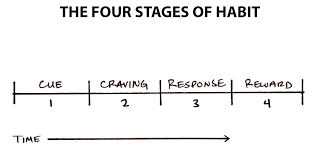FIRST LAW: MAKE THE CUE OBVIOUS

FIRST LAW: MAKE THE CUE OBVIOUS Habits are mental shortcuts learned from experience. In a sense, a habit is just a memory of the steps you previously followed to solve a problem in the past. Whenever the conditions are right, you can draw on this memory and automatically apply the same solution. The ultimate purpose of habits is to solve the problems of life with as little energy and effort as possible. LAWS OF HABIT CREATION Eliminate the cue and your habit will never start. Reduce the craving and you won’t experience enough motivation to act. Make the behavior difficult and you won’t be able to do it. And if the reward fails to satisfy your desire, then you’ll have no reason to do it again in the future. Without the first three steps, a behavior will not occur. Without all four, a behavior will not be repeated. In summary, the cue triggers a craving, which motivates a response, which provides a reward, which satisfies the craving and, ultimately, becomes associated with th...



